Keeping ELDs Up and Running
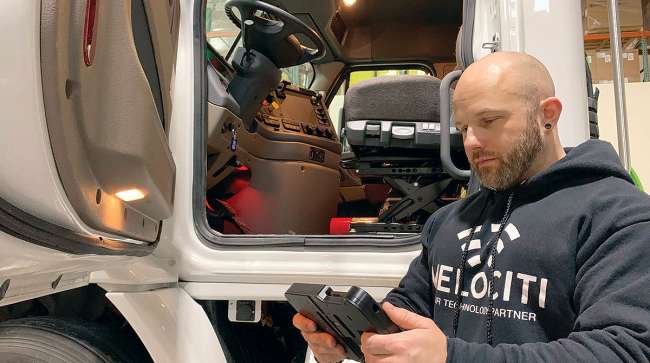
[Stay on top of transportation news: Get TTNews in your inbox.]
Electronic logging devices are now a mission-critical component of regulatory compliance in trucking, but anything from hardware failure to a lack of cellular connectivity can create disruptions.
Since the federal ELD mandate took full effect in late 2019, nearly all longhaul truck drivers have been required to record their hours-of-service information on ELDs instead of paper logbooks or older e-log systems that predated the regulation.
However, ELDs, like most any other electronic device, are not immune to technical problems.
“It is important to remember that ELDs are computers, and computers can occasionally malfunction. In our experience, many of these occurrences can be resolved with some simple troubleshooting,” said Glenn Williams, vice president of product management for Trimble Transportation.
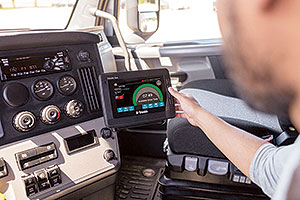
A driver uses an in-cab device from Trimble. (Trimble)
Technology suppliers said they closely monitor their devices to proactively identify issues, roll out software updates and employ a variety of troubleshooting mechanisms to help minimize the risk of a problem.
But naturally, fleets still occasionally encounter technical issues with their ELDs.
Velociti, a technology deployment company, also offers a device monitoring and repair service known as VeloCare. In 2019, 18.6% of the ELDs tracked under VeloCare experienced performance issues that had to be addressed, Velociti President Deryk Powell said.
Some problems arise on an individual device, while other issues have been more widespread.
On Nov. 3, ELD provider Omnitracs experienced disruptions from a “GPS rollover event.” The company’s older MCP 50, MCP 110 and MCP 200 telematics systems were affected, resulting in customers’ inability to access accurate time and location data. The problem was resolved within a few days.
And on Jan. 1, Trimble began to observe computer software rebooting issues in a subset of its customer base utilizing the PeopleNet g3 onboard computer.
“Once we identified the root cause, we quickly worked to communicate and provide options to these customers to address this issue. A software update was made available to customers on the evening of Jan. 1,” Williams said.
ELD providers said they regularly update their software to fix problems, improve the customer experience or comply with additional guidance from the Federal Motor Carrier Safety Administration.
“We’re constantly tweaking and updating the system,” said Fred Fakkema, vice president of compliance for Zonar Systems.
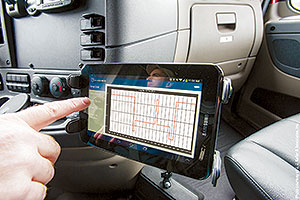
A driver checks his hours-of-service information on an ELD from J.J. Keller & Associates. (J.J. Keller & Associates)
Amy Daley, a senior product manager at regulatory compliance firm J.J. Keller & Associates, said extensive testing is conducted before software updates are released to ensure changes don’t negatively affect the product or alter compliance.
Jai Ranganathan, vice president of products for KeepTruckin, said the technology provider has tried to limit the dependency of the software on the device to other things happening in the system, which limits how many places a bug can happen. He said software updates happen on the server and the device itself. “On the server, updates happen frequently,” he said. “That is why we have the separation of software on the device. The software on the device is much more slowly updated.”
Ranganathan said KeepTruckin updates a small number of devices first and ensures they remain stable, then rolls those updates out to more devices as the company gains confidence.

More Q2 iTECH stories
Fakkema said Zonar also conducts tests to ensure the changes won’t create issues with other elements of a telematics system. The testing adds to the time it takes to release an update.
Once released, software updates can be deployed over the air, which minimizes downtime, said Michael Ahart, vice president of regulatory affairs at Omnitracs.
Ahart said it is essential to distinguish between an ELD malfunction and a device failure.
ELDs are required to identify and notify drivers of specific malfunction and diagnostic events. In contrast, device failures may result from a low battery, outdated operating systems, improper installation or wiring harness damage, he explained.
J.J. Keller’s customer service team has a matrix with diagnostics and codes that can be pulled from mobile applications for troubleshooting.
“We do not have to burden the driver at all,” Daley said, explaining that most issues can be fixed remotely. “If our customer care team is seeing a particular unit isn’t getting a data point, they can make a call to get a configuration change.”
Zonar’s Fakkema said a driver or account setup issue can cause a malfunction.
“You have to have a driver profile set up in the system as outlined in the ELD mandate for account setup. There is specific information required,” he said, adding that missing fields create problems.
Orbcomm uses automated and manual checks to monitor devices.
“We are looking at the same things FMCSA looks at — odometer jumps, engine hours accumulating, any unusual gaps in communication. These are things we want to look at to see if something is happening to the vehicle,” said Scott Stofer, Orbcomm’s director of product management.
Orbcomm has dedicated teams testing and conducting root cause analysis to help identify needed improvements.
Scott Sutarik, vice president of commercial vehicle solutions for Geotab, said that in some cases, the carrier might be able to fix an issue themselves with a reinstall.
“Geotab uses BigQuery to monitor devices, allowing various teams to detect device failure, ELD malfunctions, transfer file issues, high data usage and bug reports, allowing for pre-emptive, fast resolution,” he said.

COVID-19 has been a wakeup call to many businesses. Knowing the location and status of freight makes all the difference in navigating uncertainty. Host Seth Clevenger speaks with supply chain visibility experts Glenn Koepke and Francis Roy. Hear a snippet, above, and get the full program by going to RoadSigns.TTNews.com.
Many factors can cause technical problems, but one of the biggest reasons ELDs go out of service is cell connectivity.
“Drivers often go through pockets that don’t have connections,” KeepTruckin’s Ranganathan said. “As soon as it comes back, it brings things back.”
Sutarik said Geotab offers alternatives to reverting to paper logs when a vehicle is outside of cellular range for an extended period. These include a clock in/out feature that allows drivers who have already logged into the application to document the start and end time of their workday, as well as the IOX-USB that allows for real-time automatic duty status logs, he said.
One common reason for a failure is that the driver hasn’t connected the ELD properly or is not connecting the app to the ELD, J.J. Keller’s Daley said.
“We see data transfer errors. If the email server is down, it may trigger a malfunction. It may clear the very next day when it goes through,” she said.
Geotab’s Sutarik said he has seen failures from a conflict between the ELD and the mobile device operating system, wired interfaces, losing connectivity, battery life of mobile devices, installation problems and a lack of training.
To help minimize issues, Ahart said Omnitracs uses a direct connection to the truck’s electronic control module, avoiding a wireless interface. “This direct connection is to ensure that we are able to reliably request and record the information required by the ELD technical specifications,” he said.
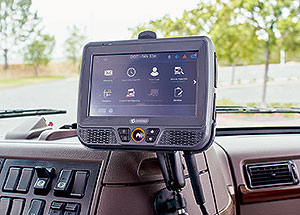
An electronic logging device from Omnitracs. (Omnitracs)
VeloCare offers call center support to help drivers who may get confused with logins or settings.
“I am not only driving a truck. Now I’m a part-time IT guy,” Velociti’s Powell said.
The trucking industry also can be a rough environment for devices, with extreme temperatures and strong vibrations.
“Those are the conditions you plan for,” KeepTruckin’s Ranganathan said. “We are on our third generation of hardware, and each generation has gotten more and more robust so it can handle more and more conditions.”
Lucas Mowrey, safety director for Grand Island Express, said the fleet’s biggest issue has been with batteries.
“The trucks are getting cold, and it is zapping the battery,” he said. “You don’t replace the battery. You have to replace the whole unit.”
Accidental damage and device tampering are driving a lot of ELD maintenance issues, Velociti’s Powell said.
Early on, Stofer said Orbcomm saw a lot of drivers unplugging the devices. Problems can also arise during maintenance.
“They can unplug it to do some extended diagnostics and forget to plug it back in,” he said. “Cables can get nicked when maintenance pulls the dash apart for something else.”
Omnitracs’ Ahart said it is crucial for fleets to consider steps they can take to make their ELDs more reliable.
“Just as the vehicle requires preventive maintenance, so does the ELD,” he said.
It is essential to have the latest operating system and firmware loaded on the device.
“This includes updating the operating system on a bring-your-own-device tablet or phone,” Ahart said. “Additionally, periodically inspect the wiring harness and connections and repair or replace in the event there is wiring damage or corrosion found.”
Time is of the essence if a problem occurs.
“Many ELDs automatically notify the motor carrier that a malfunction has occurred,” Ahart said. “If the ELD does not provide that service, the driver is required to provide written notice to the motor carrier within 24 hours of the occurrence.”
Trimble’s Williams said fleets should outline reporting procedures for drivers, such as an email, a text message or listing it on a driver vehicle inspection report, as well as who in the company is responsible for working with the vendor when an ELD malfunctions.
Under the federal mandate, fleets have eight days to make a repair, but some customers have a tighter window, Velociti’s Powell said.
“We’ll analyze that issue first to see if there is something we can do to resolve this issue quickly. If not, we can ship replacement hardware,” he said.
VeloCare maintains inventory at its company headquarters and some technicians keep hardware with them to help speed the repair process.
“Once we make contact with a driver, it can take three to four days to get to a driver to make that swap,” Powell said.
Daley said J.J. Keller advises drivers to revert to paper logs if a malfunction occurs to ensure they are in compliance. The company ships out a paper logbook with every ELD it sells. However, Daley said this can be a gray area because the log will still function.
FMCSA has published guidance indicating that if the malfunction does not affect the accuracy of hours-of-service information, drivers don’t necessarily have to go to paper logs, Orbcomm’s Stofer said.
“If there is some component that isn’t acting just right, as long as you can make your on-duty and off-duty, driving or sleeper berth, you can stay on electronic logs,” he said.
Fleets take steps to ensure their drivers can continue to record their HOS information in the event of an ELD malfunction.
Cargo Transporters equips its trucks with an emergency logbook packet that includes a paper logbook. “Drivers are only authorized to go to paper logs after being authorized by my department to do so,” said Shawn Brown, Cargo Transporters’ vice president of safety. “All paper logs are then entered into the HOS system manually and the unit in the truck is fixed. Paper logs are retained for six months as per FMCSA rules.”
If an ELD is malfunctioning or the device has failed, and the problem cannot be resolved on the spot, the driver will be advised to reconstruct the record -of-duty status for both the current day and the past seven consecutive days, Omnitracs’ Ahart said.
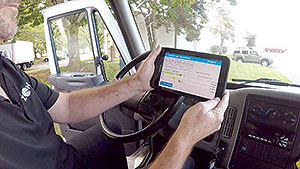
A driver uses an electronic logging device from Zonar to check his available driving time under federal hours-of-service limits. (Zonar)
Mowrey of Grand Island Express said only two of his company’s drivers have had to revert to paper logs. “We’ve had some blips, but we haven’t had a fleet outage,” he said, adding that when units have had to be replaced, Zonar Systems has gotten them back quickly. “We’ve never had an instance where we went over the eight days.”
At KeepTruckin, the number of failures has gone down, Ranganathan said.
“As we’ve gotten more and more users, we’ve been able to get more experience and address any of the issues. Over time we can get better faster,” he said.
Cargo Transporters’ Brown said the devices typically work seamlessly.
“In the rare cases we experience issues, it is usually due to an individual problem with the unit in the truck and not part of large-scale issues,” he said.
Want more news? Listen to today's daily briefing:


